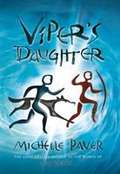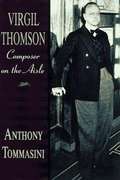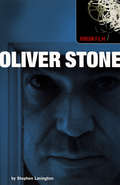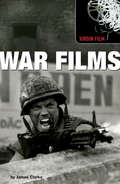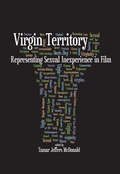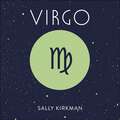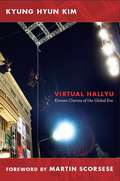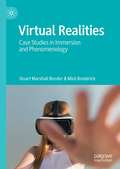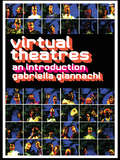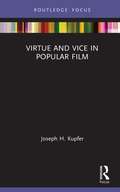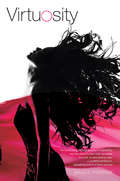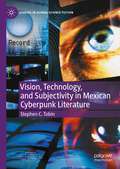- Table View
- List View
Violet's Music
by Angela Johnson Laura Huliska-BeithThere's nothing Violet loves more than music, and she plays or sings every chance she gets. But where are the other kids like her-kids who think and dream music all day long? As a baby, in kindergarten, at the beach and the zoo, she never gives up looking for companions. And then one summer day. . . Bright, lively, and lyrical, this is a book for kids who march to a different drummer. "Violet's Music" sings to us that the right friend is always out there-as long as we keep looking and hoping, and above all, staying true to ourselves. "
Viper's Daughter (Wolf Brother #7)
by Michelle PaverViper's Daughter is the seventh book in the classic series which began with Wolf Brother. Like the previous books in the series, this book takes place in northern Scandinavia. The wildlife which Torak and Renn encounter on their adventures is appropriate to the region, as are the seasonal fluctuations in the hours of daylight.
Virgil Thomson: Composer on the Aisle
by Anthony TommasiniIn the first full-scale biography of a dominating figure in twentieth-century American music, Anthony Tommasini tells the richly textured story of Virgil Thomson's experiences as a composer, influential critic, and gay man. Writing with exclusive, full access to Thomson's papers and from extensive interviews and research, he recounts: Thomson's early years in turn-of-the-century Kansas City's strange mixture of antebellum racial divides. . . his first steps in the arts, guided by a troubled older man, himself a closeted homosexual in a time when disclosure could destroy a life. . . the crystallizing of his musical ambitions as an often-contentious student of Nadia Boulanger's in Paris. . . his pioneering collaboration with Gertrude Stein on Four Saints in Three Acts. . . his rivalry with fellow composers such as Aaron Copland. . . how he settled personal scores and advanced his own agenda during his reign on the New York Herald Tribune as America's most important, and best, music critic. . . his lasting impact on, and sometimes troubled interactions with, younger composers such as Leonard Bernstein, John Cage, Paul Bowles, Ned Rorem, and Philip Glass. . . and through it all the unending struggle to write, and win an audience for, music that spoke directly and simply to the life of his time. --BOOK JACKET. Title Summary field provided by Blackwell North America, Inc. All Rights Reserved
Virgin Film: Oliver Stone
by Stephen LavingtonThree-time Oscar winner Oliver Stone is one of the most controversial and well-known contemporary American directors. He began his professional life as a screen writer and was responsible for the scripts of Midnight Express and Scarface. As a director he made one of the all-time great Vietnam war movies, Platoon, and went on to helm such definitive cinematic works as Wall Street, Born on the Fourth of July, JFK, Natural Born Killers and, most recently, Alexander - an epic biography of the legendary Greek king starring Colin Farrell and Anthony Hopkins.This indispensable guide takes each of Stone's writing and directoial features in chronological order, discussing them within categories such as Casting, Cut Scenes, Music Conspiriacy Theory? and Controversy. It looks at the inspiration behind his work, its connection with the real world and the story behind each film's development.Whether the subject is war, politics, sport or the defining aspects of an era, Stone is an expert at polarising audience views. This is an essential reference for all fans of Oliver Stone, writer, director and one of the most influential filmmakers of the last twenty-five years.
Virgin Film: Ridley Scott
by James ClarkeThis indispensable guide provides a thorough chronological examination of Ridley Scott's directorial career. All of Scott's films are included, along with information on his frequent collaborators, his thoughts on his own films, and a section on his unrealised projects. This is the essential reference guide to one of mainstream cinema's most diverse directors.
Virgin Film: War Films
by James ClarkeWar films have existed since the birth of cinema, typically gung-ho tales of macho derring-do. But war films are not always about bravado and bravery, they also detail the horrors of war, the sadness, the brotherhood of soldiers and comedy that can be found in the bleakest of situations, as well as the excitement of the battlefield. War Films explores defining movies of the genre in sections covering different wars as well as wars with other worlds.The book also offers links between the different films, historical and cinematic worth and profiles of key actors and directors. Among the films included are Saving Private Ryan, Dr Strangelove,Welcometo Sarajevo, The Dam Busters, Gallipoli, The Deer Hunter and Ran.
Virgin Territory: Representing Sexual Inexperience in Film
by Tamar Jeffers McdonaldA critical and in-depth investigation of how virginity is represented in film.
Virgo: The Art of Living Well and Finding Happiness According to Your Star Sign
by Sally KirkmanYou are a Virgo. You are the perfectionist and writer of the zodiac.The signs of the zodiac can give us great insight into our day-to-day living as well as the many talents and qualities we possess. But in an increasingly unpredictable world, how can we make sense of them? And what do they mean? This insightful and introductory guide delves deep into your star sign, revealing unique traits and meanings which you didn't know. Along the way, you will discover how your sign defies your compatibility, how to improve your health and what your gifts are. ***The Pocket Astrology series will teach you how to live well and enhance every aspect of your life. From friendship to compatibility, careers to finance, you will discover new elements to your sign and learn about the ancient art of astrology. Other audiobooks in the series include: Aries, Taurus, Gemini, Cancer, Leo, Virgo, Libra, Scorpio, Sagittarius,Capricorn, Aquarius, Pisces(P)2018 Hodder & Stoughton Limited
Virtual Hallyu: Korean Cinema of the Global Era
by Kyung Hyun Kim"[T]his fine book . . . . enlarges our vision of one of the great national cinematic flowerings of the last decade."--Martin Scorsese, from the forewordIn the late 1990s, South Korean film and other cultural products, broadly known as hallyu (Korean wave), gained unprecedented international popularity. Korean films earned an all-time high of $60.3 million in Japan in 2005, and they outperformed their Hollywood competitors at Korean box offices. In Virtual Hallyu, Kyung Hyun Kim reflects on the precariousness of Korean cinema's success over the past decade. Arguing that state film policies and socioeconomic factors cannot fully explain cinema's true potentiality, Kim draws on Deleuze's concept of the virtual--according to which past and present and truth and falsehood coexist--to analyze the temporal anxieties and cinematic ironies embedded in screen figures such as a made-in-the-USA aquatic monster (The Host), a postmodern Chosun-era wizard (Jeon Woo-chi), a schizo man-child (Oasis), a weepy North Korean terrorist (Typhoon), a salary man turned vengeful fighting machine (Oldboy), and a sick nationalist (the repatriated colonial-era film Spring of Korean Peninsula). Kim maintains that the full significance of hallyu can only be understood by exposing the implicit and explicit ideologies of protonationalism and capitalism that, along with Korea's ambiguous post-democratization and neoliberalism, are etched against the celluloid surfaces.
Virtual Memory: Time-Based Art and the Dream of Digitality
by Homay KingIn Virtual Memory, Homay King traces the concept of the virtual through the philosophical works of Henri Bergson, Gilles Deleuze, and Giorgio Agamben to offer a new framework for thinking about film, video, and time-based contemporary art. Detaching the virtual from its contemporary associations with digitality, technology, simulation, and speed, King shows that using its original meaning--which denotes a potential on the cusp of becoming--provides the means to reveal the "analog" elements in contemporary digital art. Through a queer reading of the life and work of mathematician Alan Turing, and analyses of artists who use digital technologies such as Christian Marclay, Agnès Varda, and Victor Burgin, King destabilizes the analog/digital binary. By treating the virtual as the expression of powers of potential and change and of historical contingency, King explains how these artists transcend distinctions between disembodiment and materiality, abstraction and tangibility, and the unworldly and the earth-bound. In so doing, she shows how their art speaks to durational and limit-bound experience more than contemporary understandings of the virtual and digital would suggest.
Virtual Production: Essential Elements on a Budget
by Mark Sawicki Juniko MoodyThis book, written by industry experts, provides a comprehensive understanding of virtual production processes, concepts, and technology – helping readers get to grips with this nascent technology.Topics covered are the history of virtual production, underlying technologies, creative potential, and production workflows. In addition, it delivers a detailed overview of the virtual production pipeline, from pre-production planning to post-production finishing. Each chapter explains specific aspects of virtual production, such as real-time rendering, motion capture, virtual cameras, LED screens, game engines, and collaborative workflows. Additionally, the book examines virtual production’s ethical and cultural implications, including the impact on actors, the representation of diverse voices, and the democratization of filmmaking.Whether you’re a student, teacher, or industry professional, Virtual Production will provide you with a solid foundation for comprehending the fundamental concepts behind a constantly evolving and intricate process.
Virtual Realities: Case Studies in Immersion and Phenomenology
by Stuart Marshall Bender Mick BroderickVirtual Realities presents a ground-breaking application of phenomenology as a critical method to explore the impact of immersive media. Specific case studies examine 360-degree documentary productions about trauma, virtual military simulations, VR exposure therapy for anxiety and posttraumatic stress disorder, and the emerging debate about regulating violent content in immersive media gaming. By addressing these texts primarily as experiences, Virtual Realities deploys an analytic and critical methodology that is sensitive to the bodily and cognitive impact of immersive media, especially via the body of an appropriately attentive researcher-critic. Virtual Realities provokes a rethinking of many of the taken-for-granted ideas and assumptions circulating in the field of immersive media. These include concepts of empathy, embodiment, the affective impact of textual and immersive properties on the users’ experience, as well as the “gee-whizz” mentality often associated with approaches to the medium. The case studies provide fresh engagement with immersive media such as cinematic VR at a time when dominant attitudes about the technology display an evangelical fascination with VR and other mixed realities as inexorably beneficial. Virtual Realities makes a compelling case for VR-phenomenology to be employed as a methodology by humanities scholars and also in cross-disciplinary applications of immersive media in fields such as psychology, human-computer interaction studies and the health sciences.
Virtual Reality Cinema: Narrative Tips and Techniques
by Eric R. Williams Carrie Love Matt LoveAward-winning cine-maVRicks Eric R. Williams, Carrie Love and Matt Love introduce virtual reality cinema (also known as 360° video or cine-VR) in this comprehensive guide filled with insider tips and tested techniques for writing, directing and producing effectively in the new medium. Join these veteran cine-VR storytellers as they break down fundamental concepts from traditional media to demonstrate how cine-VR can connect with audiences in new ways. Examples from their professional work are provided to illustrate basic, intermediate and advanced approaches to crafting modern story in this unique narrative space where there’s no screen to contain an image and no specific stage upon which to perform. Virtual Reality Cinema will prepare you to approach your own cine-VR projects via: Tips and techniques for writing, directing and producing bleeding-edge narrative cine-VR projects; More than a hundred photos and illustrations to explain complex concepts; Access to more than two hours of on-line cine-VR examples that you can download to watch on your own HMD; New techniques developed at Ohio University’s Game Research and Immersive Design (GRID) Lab, including how to work with actors to embrace Gravity and avoid the Persona Gap, how to develop stories with the Story Engagement Matrix and how to balance directorial control and audience agency in this new medium. This book is an absolute must read for any student of filmmaking, media production, transmedia storytelling and game design, as well as anyone already working in these industries that wants to understand the new challenges and opportunities of virtual reality cinema.
Virtual Reality Filmmaking: Techniques & Best Practices for VR Filmmakers
by Celine TricartVirtual Reality Filmmaking presents a comprehensive guide to the use of virtual reality in filmmaking, including narrative, documentary, live event production, and more. Written by Celine Tricart, a filmmaker and an expert in new technologies, the book provides a hands-on guide to creative filmmaking in this exciting new medium, and includes coverage on how to make a film in VR from start to finish. Topics covered include: The history of VR; VR cameras; Game engines and interactive VR; The foundations of VR storytelling; Techniques for shooting in live action VR; VR postproduction and visual effects; VR distribution; Interviews with experts in the field including the Emmy-winning studios Felix & Paul and Oculus Story Studio, Wevr, Viacom, Fox Sports, Sundance’s New Frontier, and more.
Virtual Theatres: An Introduction
by Gabriella GiannachiThe first full-length book of its kind to offer an investigation of the interface between theatre, performance and digital arts, Virtual Theatres presents the theatre of the twenty-first century in which everything - even the viewer - can be simulated. In this fascinating volume, Gabriella Giannachi analyzes the aesthetic concerns of current computer-arts practices through discussion of a variety of artists and performers including: * blast Theory* Merce Cunningham* Eduardo Kac* forced entertainment* Lynn Hershman* Jodi Orlan* Guillermo Gómez-Peña* Marcel-lí Antúnez Roca* Jeffrey Shaw* Stelarc. Virtual Theatres not only allows for a reinterpretation of what is possible in the world of performance practice, but also demonstrates how 'virtuality' has come to represent a major parameter for our understanding and experience of contemporary art and life.
Virtual Voyages: Cinema and Travel
by Jeffrey RuoffVirtual Voyages illuminates the pivotal role of travelogues within the history of cinema. The travelogue dominated the early cinema period from 1895 to 1905, was central to the consolidation of documentary in the 1910s and 1920s, proliferated in the postwar era of 16mm distribution, and today continues to flourish in IMAX theaters and a host of non-theatrical venues. It is not only the first chapter in the history of documentary but also a key element of ethnographic film, home movies, and fiction films. In this collection, leading film scholars trace the intersection of technology and ideology in representations of travel across a wide variety of cinematic forms. In so doing, they demonstrate how attention to the role of travel imagery in film blurs distinctions between genres and heightens awareness of cinema as a technology for moving through space and time, of cinema itself as a mode of travel. Some contributors take a broad view of travelogues by examining the colonial and imperial perspectives embodied in early travel films, the sensation of movement that those films evoked, and the role of live presentations such as lectures in our understanding of travelogues. Other essays are focused on specific films, figures, and technologies, including early travelogues encouraging Americans to move to the West; the making and reception of the documentary Grass (1925), shot on location in Turkey, Syria, Iraq, and Iran; the role of travel imagery in 1930s Hollywood cinema; the late-twentieth-century 16mm illustrated-lecture industry; and the panoramic possibilities presented by IMAX technologies. Together the essays provide a nuanced appreciation of how, through their representations of travel, filmmakers actively produce the worlds they depict. Contributors. Rick Altman, Paula Amad, Dana Benelli, Peter J. Bloom, Alison Griffiths, Tom Gunning, Hamid Naficy, Jennifer Lynn Peterson, Lauren Rabinovitz, Jeffrey Ruoff, Alexandra Schneider, Amy J. Staples
Virtue and Vice in Popular Film (Routledge Focus on Film Studies)
by Joseph H. KupferThis book addresses a prominent group of virtues and vices as portrayed in popular films to further our understanding of these moral character traits. The discussions emphasize the interplay between the philosophical conception of the virtues and vices and the cinematic representations of character. Joseph H. Kupfer explores how fictional characters possessing certain moral strengths and weaknesses concretize our abstract understanding of them. Because the actions that flow from these traits occur in cinematic contexts mirroring real world conditions, the narrative portrayals of these moral characteristics can further our appreciation of their import. Humility, integrity, and perseverance, for example, are depicted in Chariots of Fire, The Fabulous Baker Boys, and Billy Elliot, while the vices of envy, arrogance and vanity are captured in Amadeus, Whiplash, and Young Adult. This interdisciplinary work in philosophy and film criticism will be of great interest to scholars and students of film studies, philosophy of film, ethics, aesthetics, and popular culture.
Virtuosity
by Jessica MartinezAn intensely romantic, “brilliant debut” (Kirkus Reviews) about a dangerous addiction, a fierce rivalry, and a forbidden love.Now is not the time for Carmen to fall in love. And Jeremy is hands-down the wrong guy for her to fall for. He is infuriating, arrogant, and the only person who can stand in the way of Carmen getting the one thing she wants most: to win the prestigious Guarneri competition. Carmen’s whole life is violin, and until she met Jeremy, her whole focus was winning. But what if Jeremy isn’t just hot…what if Jeremy is better?Carmen knows that kissing Jeremy can’t end well, but she just can't stay away. Nobody else understands her—and riles her up—like he does. Still, she can’t trust him with her biggest secret: She is so desperate to win, she takes antianxiety drugs to perform, and what started as an easy fix has become a hungry addiction. Carmen is sick of not feeling anything on stage and even sicker of always doing what she’s told, doing what’s expected.Sometimes being on top just means you have a long way to fall….
Virtuosity
by Jessica MartinezAn intensely romantic, “brilliant debut” (Kirkus Reviews) about a dangerous addiction, a fierce rivalry, and a forbidden love.Now is not the time for Carmen to fall in love. And Jeremy is hands-down the wrong guy for her to fall for. He is infuriating, arrogant, and the only person who can stand in the way of Carmen getting the one thing she wants most: to win the prestigious Guarneri competition. Carmen’s whole life is violin, and until she met Jeremy, her whole focus was winning. But what if Jeremy isn’t just hot…what if Jeremy is better?Carmen knows that kissing Jeremy can’t end well, but she just can't stay away. Nobody else understands her—and riles her up—like he does. Still, she can’t trust him with her biggest secret: She is so desperate to win, she takes antianxiety drugs to perform, and what started as an easy fix has become a hungry addiction. Carmen is sick of not feeling anything on stage and even sicker of always doing what she’s told, doing what’s expected.Sometimes being on top just means you have a long way to fall….
Visible and Invisible Whiteness: American White Supremacy through the Cinematic Lens
by Alice Mikal CravenVisible and Invisible Whiteness examines the complicity between Classical Hollywood narratives or genres and representations of white supremacy in the cinema. Close readings of D.W. Griffith’s The Birth of a Nation by James Agee and James Baldwin explore these authors’ perspectives on the American mythologies which ground Griffith’s film. The intersectionality of Bordwell’s theories on Classical Hollywood Narrative versus Art Cinema and Richard Dyer’s seminal work on whiteness forms the theoretical base for the book. Featured films are those which have been undervalued or banned due to their hybrid natures with respect to Hollywood and Art Cinema techniques, such as Samuel Fuller’s White Dog and Jean Renoir’s The Southerner. The book offers comparative analyses of American studio-based directors as well as European and European émigrés directors. It appeals to scholars of Film Theory, African American and Whiteness Studies. It provides insight for readers concerned about the re-emergence of white supremacist tensions in contemporary America.
Vision 2020: Reordering Chaos For Global Survival
by Ervin LaszloThis revised edition of the classic text of the period provides both the student and the specialist with an informative account of post-Roman English society.
Vision, Technology, and Subjectivity in Mexican Cyberpunk Literature (Studies in Global Science Fiction)
by Stephen C. TobinVision, Technology and Subjectivity in Mexican Cyberpunk Literature interrogates an array of cyberpunk and post-cyberpunk science fiction novels and short stories from Mexico whose themes engage directly with visual technologies and the subjectivities they help produce – all published during and influenced by the country’s neoliberal era. This book argues that television, computers, and smartphones and the literary narratives that treat them all correspond to separate-yet-overlapping scopic regimes within the country today. Amidst the shifts occurring in the country’s field of vision during this period, the authors of these cyberpunk and post-cyberpunk narratives imagine how these devices contribute to producing specular subjects—or subjects who are constituted in large measure by their use and interaction with visual technologies. In doing so, they repeatedly recur to the posthuman figure of the cyborg in order to articulate these changes; Stephen C. Tobin therefore contends that the literary cyborg becomes a discursive site for working through the problematics of sight in Mexico during the globalized era. In all, these “specular fictions” represent an exceptional tendency within literary expression—especially within the cyberpunk genre—that grapples with themes and issues regarding the nature of vision being increasingly mediated by technology.
Visionary Film: The American Avant-Garde, 1943-2000
by P. Adams SitneyCritics hailed previous editions of Visionary Film as the most complete work written on the exciting, often puzzling, and always controversial genre of American avant-garde film. This book has remained the standard text on American avant-garde film since the publication of its first edition in 1974. <p><p>Now P. Adams Sitney has once again revised and updated this classic work, restoring a chapter on the films of Gregory J. Markopoulos and bringing his discussion of the principal genres and major filmmakers up to the year 2000.
Visions from the Upside Down: Stranger Things Artbook (Stranger Things)
by NetflixOver 200 artists present their own unique visions of Stranger Things in a stunning celebration of the runaway hit Netflix series. In honor of Stranger Things, the innovative pop culture enthusiasts at Printed In Bloodare proud to present the latest release in their ongoing series of artbooks. More than two hundred artists, drawn from the earthly dimensions of comics, illustration, fine art, videogames, and animation, have come together to bring us a unique vision of the world of Hawkins, Indiana. Come dig into this collection of more than two hundred brand-new images and see what new worlds you might discover lurking just beneath the surface. Includes art by: ORLANDO AROCENA • MATT BUSCH • BUTCHER BILLY • RIAN HUGHES • JOHN McCREA • MATT NEEDLE • GARY PULLIN • BILL SIENKIEWICZ • EILEEN STEINBACH & MORE!This ebook is best viewed on a color device with a larger screen.
Visions of Avant-Garde Film: Polish Cinematic Experiments from Expressionism to Constructivism
by Kamila KucWarsaw- and London-based filmmakers Franciszka and Stefan Themerson are often recognized internationally as pioneers of the 1930s Polish avant-garde. Yet, from the turn of the century to the end of the 1920s, Poland’s literary and art scenes were also producing a rich array of criticism and early experiments with the moving image that set the stage for later developments in the avant-garde. In this comprehensive and accessible study, Kamila Kuc draws on myriad undiscovered archival sources to tell the history of early Polish avant-garde movements—Symbolism, Expressionism, Futurism, and Constructivism—and to reveal their impact on later practices in art cinema.

